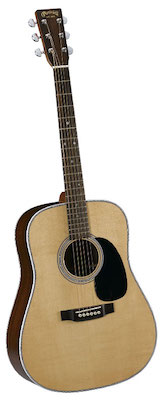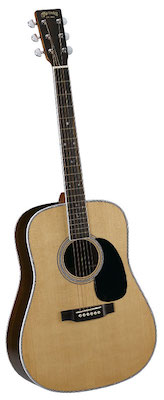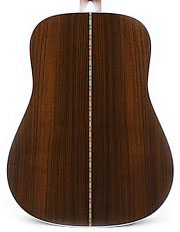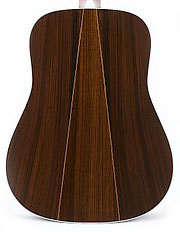

Martin D-28 Martin D-35
2015 has been a good year for the Martin D35. With Martin throwing out all the stops to celebrate its 50th anniversary, the D35 has had a resurgence in popularity among Martin players and I’ve been having more and more conversations about it as the year goes on. Unfortunately while a lot of people are becoming more aware of the model it still seems that a lot of Martin players don’t really understand what it is that makes the D35 worthy of considering when compared to its older brother, the Martin D28. Today we’re going to try to fix that. This article is going to focus a bit more on the D35 than the D28. If you’d like to hear more about the D28 in particular, be sure to check out my previous “D28 Vs HD28” article.
What’s the same?
Cosmetically and structurally, the D28 and the D35 are very similar instruments. They’re both Dreadnought sized 14-Fret long scale instruments. They both have Sitka Spruce tops, East Indian Rosewood back/sides, Standard ‘X’ straight bracing pattern, and a Low Profile neck with a 1-11/16” nut and a 2-1/8” bridge spacing. They have the same finish, pickguard, bridge pins, and tuning machines. Oh, and they both come in Martin 640 Hardshell Thermoplastic Cases.
Before we go too deep into the structural differences between the two instruments, let’s take a quick look at the aesthetic differences. For starters D-35 is one of the few Martin guitars that has a bound neck. It features a distinctive White Boltaron binding running along 3 sides of the fretboard which is matched with a white Boltaron side inlay on the body of the instrument. Taken as a whole these slight cosmetic upgrades give the guitar a classier vibe when compared to the more sparse, workingman's aesthetic on the D-28.

The bound neck of a D-35
The most obvious difference between the D28 and the D35 is the number of pieces of wood used on their backs. The D28, like most Martin instruments, has a symetrical 2 piece back. This construction means that Martin needs bigger pieces of clean Rosewood. As Brazilian Rosewood got harder to find in the early 1960s Martin realized that, rather than simply waste the pieces of Brazilian Rosewood that were rejected for being too small for the D28 they could utilize them on an instrument with a 3 piece back.
This three piece design necessitated some changes to what at that time were Martin’s standard Dreadnought construction methods. Martin realized quickly that a guitar back is made from 3 pieces of wood with perpendicular grain instead of two it ends up being much stiffer. Their first attempt, which was then known as the X-35, had almost identical back bracing to what was found on a D28. The guitar wound up being far too bassy. To compensate for this, Martin decided to copy the lighter rear bracing of their 00 sized instruments for the D35 which allowed the back to vibrate as freely as possible without compromising structural integrity.


On the left we have the standard 2-Piece back of a D-28. On the right we have the iconic 3-Piece back of a D-35
Since the guitar’s back was already so lightly braced, Martin decided to keep the ball rolling and lighten the top braces on the D35 as well. At the time almost all Martin dreads were made with 5/16” X braces while smaller bodied instruments were braced with 1/4” braces. Martin decided to take the chance and apply the 1/4” 000 bracing pattern to their new Dreadnought. Three more prototypes later and Martin was ready to unveil the D35 to the world.
But talking about brace thickness in numbers alone is theoretical. What happens “in the field”?
In my own highly subjective opinion, the D-35 does everything the D-28 does but it does it just a bit better. The D-35 has all of the warmth and bass that you’d come to expect from a Martin Dreadnought. The difference is that, along with the typical low end you also get a crystal clear high end response. The highs on the D-35 are loud and sustaining, giving the guitar an incredible balance across the fretboard that you just don’t find in 28 series Dreads. Combine this with the D-35s better harmonic response, giving you a guitar that sounds more nuanced and lively than what came before it.
Although the initial reason for it’s creation was one of necessity, the D35 has become a mainstay in Martin’s lineup for reasons that go beyond financial. With its lighter bracing and eyecatching aesthetics, the D35 meets a need in the Martin lineup, offering an original tone and balance that isn’t found in any other Martin model. Personally I’ve found that it gives a sound that works great for solo guitar/vocal arrangements as well as smaller acoustic groups because of its fuller, more lush sound. The D28, on the other hand, has a more bass oriented tone that I feel works better for larger arrangements where you need to be careful not to step on the toes of the instruments around you.
For those of you who were unsure what the D-35 really offered, I hope this cleared things up.
Which do you prefer, the D-28 or the D-35? Be sure to let us know in the comment section.